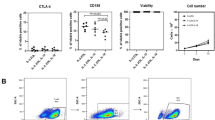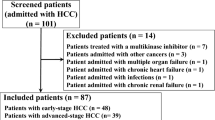Abstract
The CD95 (APO–1/Fas) system is an important mediator of T–cell cytotoxicity. We investigated this system in 22 hepatocellular carcinomas (HCCs) from patients. All HCCs had partially or completely lost the expression of the CD95 receptor constitutively expressed by normal liver cells and might thus evade CD95–mediated killing. We also considered a new mechanism of immune evasion, namely, the active destruction of T–lymphocytes by tumor cells expressing CD95 ligand (CD95L). CD95L messenger RNA and protein could be detected in the HCCs. In coculture experiments, HepG2 hepatoblastoma cells, expressing CD95L mRNA after treatment with cytostatic drugs, killed CD95+ Jurkat lymphocytes. Our data suggest that tumor cells can evade immune attack by down–regulation of the CD95 receptor and killing of lymphocytes through expression of CD95L.
This is a preview of subscription content, access via your institution
Access options
Subscribe to this journal
Receive 12 print issues and online access
$209.00 per year
only $17.42 per issue
Buy this article
- Purchase on Springer Link
- Instant access to full article PDF
Prices may be subject to local taxes which are calculated during checkout
Similar content being viewed by others
References
Krammer, P.H., Behrmann, I., Daniel, P., Dhein, D. & Debatin, K.-M. Regulation of apoptosis in the immune system. Curr. Opin. Immunol. 6, 279–289 (1994).
Apasov, S., Redegeld, F. & Sitkovsky, M. Cell-mediated cytotoxicity: Contact and secreted factors. Curr. Opin. Immunol. 5, 404–410 (1993).
Lowin, B., Hahne, M., Mattmann, C. & Tschopp, J., T-cell cytotoxicity is mediated through perforin and Fas lytic pathways. Nature 370, 650–652 (1994).
Kägi, D. et al Cytotoxicity mediated by T cells and natural killer cells is greatly impaired in perforin-deficient mice. Nature 369, 31–37 (1994).
Kägi, D. et al. Fas and perforin pathways as major mechanisms of T-cell-mediated cytotoxicity. Science 265, 528–530 (1994).
Rouvier, E., Luciani, M.-F. & Golstein, P. Fas involvement in Ca2+-independent T cell-mediated cytotoxicity. J. Exp. Med. 177, 195–200 (1993).
Gilette-Ferguson, I. & Sidman, C.L. A specific intercellular pathway of apoptotic cell death is defective in the mature peripheral T cells of autoimmune Ipr and gld mice. Eur. J. Immunol 24, 1181–1185 (1994).
Hanabuchi, S. et al. Fas and its ligand in a general mechanism of T-cell-mediated cytotoxicity. Proc. Natl. Acad. Sci. USA 91, 4930–4934 (1994).
Ju, S.T., Cui, H., Pauka, D.J., Ettinger, R. & Marshak-Rothstein, A. Participation of target Fas protein in apoptosis pathway induced by CD4+ Th1 and CD8+ cytotoxic T cells. Proc. Natl. Acad. Sci. USA 91, 4185–4189 (1994).
Stalder, T., Hahn, S. & Erb, P. Fas antigen is the major target molecule for CD4+ T-cell mediated cytotoxicity. Immunology 152. 1127–1133 (1994).
Vignaux, F. & Golstein, P. Fas-based lymphocyte-mediated cytotoxicity against syngeneic activated lymphocytes: A regulatory pathway? Eur. J. Immunol. 24, 923–927 (1994).
Leithäuser, F. et al. Constitutive and induced expression of APO-1, a new member of the NGF/TNF receptor superfamily, in normal and neoplastic cells. Lab. Invest. 69, 415–429 (1993).
Galle, P.R. et al. Involvement of the CD95 (APO-1/Fas) receptor and ligand in liver damage. J. Exp. Med. 182, 1223–1230 (1995).
Ogasawara, J. et al. Lethal effects of the anti-Fas antibody in mice. Nature 364, 806–809 (1993).
Bellgrau, D. et al. A role for CD95 ligand in preventing graft rejection. Nature 377, 630–6322 (1995).
Griffith, T.S., Brunner, T., Fletcher, S.M., Green, D.R. & Ferguson, T.A. Fas lig-and-induced apoptosis as a mechanism of immune privilege. Science 17, 1189–1192 (1995).
Badley, A.D. et al. Upregulation of Fas ligand expression by human immunodeficient virus in human macrophages mediates apoptosis of uninfected T lym phocytes. J. Virol. 70, 199–206 (1996).
Volkmann, M. et al. P53 overexpression is frequent in European hepatocellular carcinoma and largely independent of the codon 249 hot spot mutation. Oncogene 9, 195–204 (1994).
Peter, M.E. et al. APO-1 (CD95)-dependent and-independent antigen receptor-induced apoptosis in human T and B cell lines. Int. Immunol. 7, 1873–1877 (1995).
Friesen, C., Herr, I., Krammer, P.H. & Debatin, K.-M. Involvement of the CD95 (APO-1/Fas) receptor/ligand system in drug-induced apoptosis in leukemia cells. Nature Med. 2, 574–577 (1996).
Trauth, B.C. et al. Monoclonal antibody-mediated tumor regression by induc tion of apoptosis. Science 245, 301–305 (1989).
Nicoletti, I., Migliorati, G., Paggliacci, M.C., Grignani, F. & Riccardi, C. A rapid and simple method for measuring thymocyte apoptosis by propidium iodide staining and flow cytometry. J. Immunol. Methods 139, 271–279 (1991).
Dhein, J. et al. Induction of apoptosis by monoclonal antibody anti-APO-1 class switch variants is dependent on cross-linking of APO-1 cell surface antigens. J. Immunol. 149, 3166–3173 (1992).
Tanaka, M. et al. Fas ligand in human serum. Nature Med. 2, 317–322 (1996).
Yagita, H., Seino, K.-I., Kayagaki, N. & Okumura, K. CD95 ligand in graft rejection [letter]. Nature 379, 682 (1996).
Angerer, L.M. & Angerer, R.C. In situ hybridization to cellular RNA with radio-labeled RNA probes. in In Situ hybridization: A Practical Approach (ed. Wilkinson, D.G.) 15–32 (Oxford Univ. Press, New York, 1992).
Aden, D.P., Fogel, A., Plotkin, S., Damjanov, I. & Knowles, B.B. Controlled synthesis of HBsAg in a differentiated human liver carcinoma-derived cell line. Nature 282, 615–616 (1979).
Sellins, K.S. & Cohen, J.J. Gene induction by γ-irradiation leads to DNA frag mentation in lymphocytes. Immunol. 139, 3199–3206 (1987).
Southern, E.M. Detection of specific sequences among DNA fragments sepa rated by gel electrophoresis. J. Mol. Biol. 98, 503–517 (1975).
Mariani, S.M., Matiba, B., Bäumler, C. & Krammer, P. Regulation of cell surface APO-1/Fas (CD95) ligand expression by metalloproteases. Eur. J. Immunol. 25, 2303–2307 (1995).
Author information
Authors and Affiliations
Rights and permissions
About this article
Cite this article
Strand, S., Hofmann, W., Hug, H. et al. Lymphocyte apoptosis induced by CD95 (APO–1/Fas) ligand–expressing tumor cells — A mechanism of immune evasion?. Nat Med 2, 1361–1366 (1996). https://doi.org/10.1038/nm1296-1361
Received:
Accepted:
Issue Date:
DOI: https://doi.org/10.1038/nm1296-1361
This article is cited by
-
Nasopharyngeal carcinoma: current views on the tumor microenvironment's impact on drug resistance and clinical outcomes
Molecular Cancer (2024)
-
Signaling pathways in brain tumors and therapeutic interventions
Signal Transduction and Targeted Therapy (2023)
-
Presence of CrkI-containing microvesicles in squamous cell carcinomas could have ramifications on tumor biology and cancer therapeutics
Scientific Reports (2022)
-
Immune suppression in gliomas
Journal of Neuro-Oncology (2021)
-
Lack of effective translational regulation of PLD expression and exosome biogenesis in triple-negative breast cancer cells
Cancer and Metastasis Reviews (2018)



